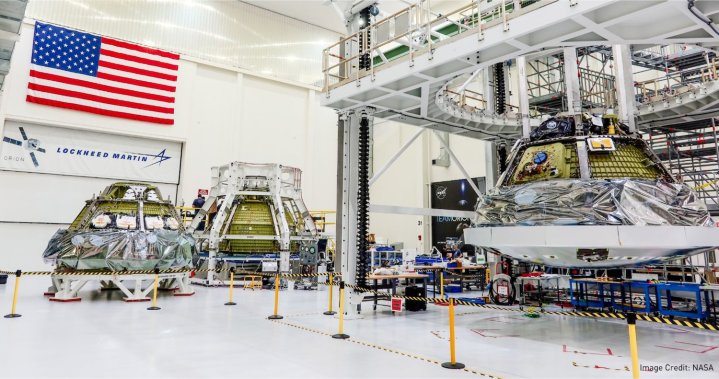
NASA has shared an image of three spacecraft that will play a central role in its next three Artemis missions to the moon.
Having already successfully tested the Orion spacecraft on a lunar flyby at the end of last year after being blasted to space by NASA’s new Space Launch System rocket, the American space agency is now overseeing the building of three more Orion capsules for upcoming Artemis missions.
In the image (top), the Orion craft for Artemis II is seen on the right, inside the high bay of the Neil Armstrong Operations and Checkout Building at NASA’s Kennedy Space Center in Florida. Artemis III is on the left, and Artemis IV in the middle.
Orion manufacturer Lockheed Martin tweeted the same image with the comment: “The future of @NASA_Orion is looking pretty good.”
Each Orion capsule is in a different stage of production as technicians and engineers prepare the spacecraft to carry astronauts toward the moon on the upcoming missions, NASA said.
Technicians recently installed the heat shield on the Artemis II crew module, and teams are aiming to carry out acoustic testing in the next few months. When ready, the crew module will be linked to the service module in preparation for the lunar mission.
Artemis II is currently scheduled for November 2024 and will carry NASA astronauts Christina Koch, Victor Glover, and Reid Wiseman, plus Canadian Space Agency astronaut Jeremy Hansen. The astronauts won’t land on the moon but instead perform a flyby, coming within a short distance of the lunar surface before returning home.
A successful mission will pave the way for Artemis III, which will endeavor to put the first woman and first person of color on the lunar surface. In this mission, Orion will carry the astronauts to a lunar orbit where they’ll transfer to a modified version of SpaceX’s Starship lander. While currently slated for 2025, sticking to that date depends to some extent on the progress SpaceX makes with the testing of its Super Heavy and Starship vehicle.
Artemis IV, meanwhile, is planned for 2028 and will also put astronauts onto the lunar surface.
Editors’ Recommendations
Credit: Source link


Comments are closed.